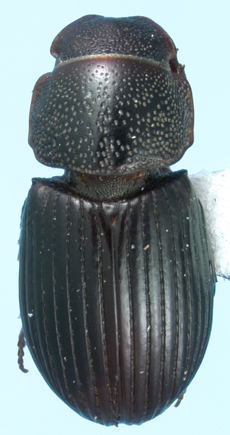 |
|||||||
|
|||||||
Dialytellus Brown 1929
Dialytellus Brown 1929: 211
Photo by P. Skelley.
|
||
|
||
| Aphodiinae Overview | ||
| Aphodiini Key |
Type species. Aphodius humeralis LeConte 1878: 459, by original designation.
Diagnosis. Body length 3.2-4.6 mm, elongate, robust, dark brown to black. Lateral margin of pronotum emarginate at base. Elytral humerus dentate.
Distribution. Northeastern North America.
Composition. Dialytellus contains 2 species.
Dialytellus dialytoides (Fall 1907: 247) [Aphodius], SE-Canada, NE-USA.
Dialytellus tragicus Schmidt 1916: 97, SE-Canada, NE-USA.
= Aphodius humeralis LeConte 1878: 459 [not Aphodius
haemorrhoidalis var. humeralis Mulsant 1842].
= Aphodius lecontei Balthasar 1941: 93 [unnecessary
replacement name].
Life History. Rarely collected, adults have been found on deer dung. Some evidence indicates they may also feed on rotting fungus.
Larvae. Unknown.
References:
Gordon, R. D., and P. E. Skelley. 2007. A monograph of the Aphodiini inhabiting the United States and Canada (Coleoptera: Scarabaeidae: Aphodiinae). Memoirs of the American Entomological Institute 79: 580 pp.
|
||||
| Author: Paul Skelley Generated on: 01/MAY/08.....Last modified: 01/MAY/08 University of Nebraska State Museum - Division of Entomology |
